 |
 |
 |
 |
 |
 |
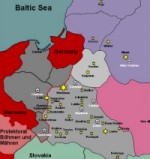 |
| Ghettos |
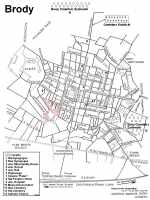 |
From September 1939 until 1 July 1941 the town was under Soviet occupation. At that time some Jews collaborated with the Soviets and others, mainly wealthy people, were prosecuted and deported to Siberia. Before the German army entered the town, Brody was bombed for eight days. Many houses were completely destroyed and the Soviet army evacuated the town in panic. German units captured the town on 1 July 1941 and were warmly welcomed by the local Ukrainian population. From the beginning of the occupation the Jewish apartments were plundered by German soldiers and their Ukrainian collaborators.
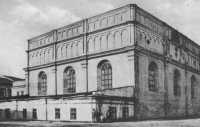 |
| The Synagogue |
In January 1942, work camps for Jews were created near Brody at Jaktorow, Sasow and Laski. 430 young men from Brody were sent to these camps. In the first half of 1942, the aggregate of Jews imprisoned in these camps rose to about 1,500, but their number dwindled rapidly in the second half of 1942 due to the high death rate caused by mistreatment, starvation and disease. Jewish women worked mainly in the manors near the town. When rumours spread about the first deportations, the Jews paid large sums of the money to acquire work cards. At the same time, people began to construct shelters in their homes.
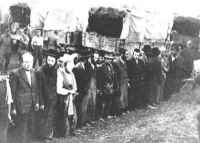 |
| Assembled for Deportation |
Information about the fate of the deportees was known to the Jews of Brody soon after the first deportation. Rafal Schleger, then a 12 year-old boy, heard about Belzec just after the first "action":
"Railway workers from the trains that carried people to the camp told about Belzec. They described that there is an iron floor on which people are placed and electricity kills them."
Rumours about using electricity for the killing of Jews in Belzec abounded at that time in the whole of eastern Galicia.
Among the Germans in Brody there was one family who tried to aid the Jews. Liselotte Hassenstein and her husband Otto, who worked for the Forest Administration, were very active during the time of the "actions" in assisting the Jews. Otto Hassenstein saved many Jews by assigning them to forest work. He told everyone:
"Whoever works for me needs to be treated honestly, no matter if they are a Jew, a Pole or a German."
Of course, this work in the forests could only help in the short term, but still it was of great value during the deportations. Both Hassensteins were arrested by the Gestapo in 1943 when somebody denounced them for sheltering in their attic a Jewess who had jumped off a death train. During the "actions" in the town Liselotte Hassenstein had frequently hidden Jews in her attic. The Hassensteins were taken to Lwow and sentenced to two years imprisonment. Mrs. Hassenstein was released from prison because she was in bad health, but was still sent to KZ Ravensbrück to complete her sentence.
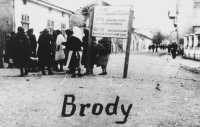 |
| Ghetto Entrance * |
The office of the Judenrat was situated outside of the ghetto, on Boznicza Street. The ghetto was surrounded by barbed wire and completely overcrowded. Because it was not permitted to have any contact with the non-Jewish inhabitants of the town, most of the Jews starved. Only those who worked outside of the ghetto had the possibility of smuggling in some food, but it was not enough. The members of the Judenrat confiscated almost all of the smuggled food for themselves and their families. Officially, the daily portion of bread for everybody in the ghetto measured 80 g. There was a kitchen in the ghetto for poor people, but even there people had to pay for food. The price was not great, but in a situation in which most of the people had no money, only relatively wealthy individuals could afford to eat the soup in the people's kitchen. At the same time there was a typhus epidemic in the ghetto. During the winter of 1942/1943, about 1,500 Jews died in Brody from starvation and typhus.
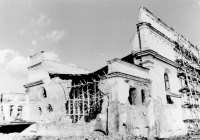 |
| Ruins of the Synagogue * |
The final liquidation of the ghetto occurred on 21 May 1943, in the course of which members of underground organisation opened fire on the Ukrainian policemen and Germans. Several Ukrainians were killed. The Germans set fire in the ghetto and many people were burned alive. Others were executed on the streets or in the forest near the town but in the chaos that ensued, many Jews escaped from the ghetto. Among them were some members of the resistance, led by Weiler. He survived the war in a partisan unit. Of the many people who tried to escape only a very few survived with the help of Poles and Ukrainians. In this final deportation, more than 3,000 inmates of the ghetto were probably sent to Sobibor. From the entire pre-war Jewish population of 10.000 in Brody, only 88 people survived until the liberation.
Trial:
Kaiserslautern, 1976 - 82:
Ab., Wolfgang Maria Marquardt Viktor - Case dismissed, acquittal
Hei., Hans - 3 years
Polizei Pol.Rgt.Süd -Nachrichtenabteilung 2-
Crimes committed in July – September 1941 in: unknown, Brody
Mass shooting of at least 100 Jews at an unknown location in the Kiev area (near Polonnoye), and approximately 60 Jews in Brody.
Photos: USHMM *
Brody Map: Ner Tamid: Yizkor leBrody (An Eternal Light: Brody Memorial Book), Israel, 1994.
Sources:
Gutman, Israel, ed. Encyclopedia of the Holocaust, Macmillan Publishing Company, New York, 1990
Archive of the Jewish Historical Institute in Warsaw. Testimonies by survivors.
www.shtetlinks.jewishgen.org/brody
 |
| 7,000 Jews lived in the ghetto |
© ARC 2005